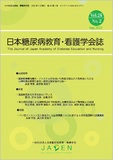Japanese
English
- 販売していません
- Abstract 文献概要
- 参考文献 Reference
目的:糖尿病性腎症患者を対象に,6年間の後方視的調査を行い,チーム医療による個別的な予防指導と腎機能や血糖管理などの評価指標との関連について明らかにする.
方法:腎症2期以降の患者について,診療記録を用いて個別予防指導群(介入群)と通常診療群(非介入群)で評価指標を比較し,HbA1c,eGFR,血圧を従属変数とした多重ロジスティック回帰分析を行った.
結果:分析対象者は介入群224名,非介入群209名であった.ベースライン(開始時)において,HbA1cは介入群7.5(6.8-8.9)%,非介入群7.2(6.6-8.1)%で介入群の方が有意に高かったが(p<0.05),観察期間終了時,介入群では有意に改善を認めた(p<0.01).また,介入回数が多いことがHbA1cの維持・改善に有効で,eGFRはベースライン時腎症3期以降では悪化を認めた.
結論:予防指導は腎症進行例では限界を示したが,血糖管理には有効であることが示唆された.
Objective:To implement a 6-year retrospective study of patients with diabetic nephropathy and to determine the relationship between individual preventive guidance through team-based medical care and assessment indices such as renal function and glycemic control.
Methods:Patients with stage 2 or later nephropathy were divided into the group with individual prevention guidance (intervention group) and the usual care group (non-intervention group). Multiple regression analysis was used to compare them for assessment indices based on their medical records, with HbA1c, eGFR, and blood pressure as the dependent variables.
Results:The study included 224 subjects in the intervention group and 209 subjects in the non-intervention group. At baseline, HbA1c was significantly higher in the intervention group (7.5 [6.8-8.9]%) than in the non-intervention group (7.2 [6.6-8.1]%) (p<0.05), but it improved significantly in the intervention group at the end of the observation period (p<0.01). In addition, more frequent interventions were effective in maintaining or improving HbA1c, and eGFR deteriorated in stage 3 or later nephropathy at the baseline.
Conclusion:Although preventive guidance showed limitations in patients with advanced nephropathy, it was effective for glycemic control.
Copyright © 2022, Japan Academy of Diabetes Education and Nursing. All rights reserved.


